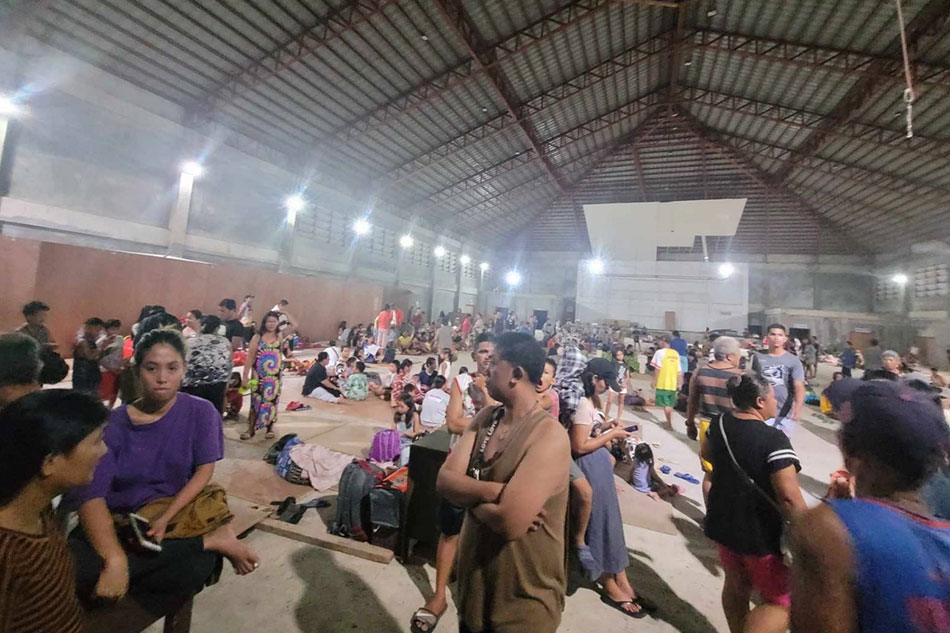Recent Mindanao quakes are interconnected: Phivolcs | ABS-CBN

Welcome, Kapamilya! We use cookies to improve your browsing experience. Continuing to use this site means you agree to our use of cookies. Tell me more!
Recent Mindanao quakes are interconnected: Phivolcs
Recent Mindanao quakes are interconnected: Phivolcs
Josiah Antonio,
ABS-CBN News
Published Jan 10, 2024 05:03 PM PHT
MANILA — Strong quakes are still possible in Surigao del Sur and in the rest of Mindanao following the 7.4-magnitude earthquake last December 2, state seismologists said in a report published on Wednesday.
MANILA — Strong quakes are still possible in Surigao del Sur and in the rest of Mindanao following the 7.4-magnitude earthquake last December 2, state seismologists said in a report published on Wednesday.
According to the 11-page report, Phivolcs used the technique called Coulomb stress transfer modeling to show how a strong quake may influence new strong quakes.
According to the 11-page report, Phivolcs used the technique called Coulomb stress transfer modeling to show how a strong quake may influence new strong quakes.
"This technique revolves around the concept that areas with stress increase are areas where faults are promoted to failure they are likely to host earthquakes," the report said citing a study by Ross Stein on "The role of stress transfer in earthquake occurrence."
"This technique revolves around the concept that areas with stress increase are areas where faults are promoted to failure they are likely to host earthquakes," the report said citing a study by Ross Stein on "The role of stress transfer in earthquake occurrence."
"In contrast, those with stress decrease are areas where faults are inhibited from failure — they are less likely to generate earthquakes," they added.
"In contrast, those with stress decrease are areas where faults are inhibited from failure — they are less likely to generate earthquakes," they added.
ADVERTISEMENT
'SEISMIC EVENTS ARE INTERCONNECTED'
Relating a 6.8-magnitude earthquake on Dec. 4 to the earlier earthquake, the state seismologist said that the 7.4-magnitude increased the stress by 0.4 to 0.5 bar at the location of the former quake, initiating a triggering effect.
Relating a 6.8-magnitude earthquake on Dec. 4 to the earlier earthquake, the state seismologist said that the 7.4-magnitude increased the stress by 0.4 to 0.5 bar at the location of the former quake, initiating a triggering effect.
"This stress transfer mechanism essentially means that the stress from the first quake influenced the occurrence of the second one. This emphasizes the interconnected nature of seismic events in subduction zones," Phivolcs said.
"This stress transfer mechanism essentially means that the stress from the first quake influenced the occurrence of the second one. This emphasizes the interconnected nature of seismic events in subduction zones," Phivolcs said.
"The anticipation is for aftershocks, possibly even another mainshock, to occur in these specific areas. Furthermore, the possibility of triggering shallower earthquakes along the (Philippine Trench) is concerning. This is unwelcome news, as it suggests the potential for tsunami occurrence," they added after citing a study by Stein and Shinji Toda titled "Major earthquake strikes the Philippines, followed by unusually large aftershocks."
"The anticipation is for aftershocks, possibly even another mainshock, to occur in these specific areas. Furthermore, the possibility of triggering shallower earthquakes along the (Philippine Trench) is concerning. This is unwelcome news, as it suggests the potential for tsunami occurrence," they added after citing a study by Stein and Shinji Toda titled "Major earthquake strikes the Philippines, followed by unusually large aftershocks."
Phivolcs said that the Mindanao area should still expect strong quakes and be prepared to respond to its possible effects.
Phivolcs said that the Mindanao area should still expect strong quakes and be prepared to respond to its possible effects.
SEISMICALLY ACTIVE AREA
In a Dec. 3 primer, Phivolcs said Surigao del Sur and its neighboring provinces are in one of the seismically active regions in the Philippines.
In a Dec. 3 primer, Phivolcs said Surigao del Sur and its neighboring provinces are in one of the seismically active regions in the Philippines.
"The presence of active faults and trenches, such as the Philippine Fault and its segments, as well as the Philippine Trench, plays a significant role in generating seismic events. Additionally, there are local faults in proximity, some potentially buried by recent deposits capable of generating minor to strong earthquakes," it also said.
"The presence of active faults and trenches, such as the Philippine Fault and its segments, as well as the Philippine Trench, plays a significant role in generating seismic events. Additionally, there are local faults in proximity, some potentially buried by recent deposits capable of generating minor to strong earthquakes," it also said.
Earthquakes are a daily occurrence in the Philippines, which sits along the Pacific "Ring of Fire", an arc of intense seismic and volcanic activity that stretches from Japan through Southeast Asia and across the Pacific basin.
Earthquakes are a daily occurrence in the Philippines, which sits along the Pacific "Ring of Fire", an arc of intense seismic and volcanic activity that stretches from Japan through Southeast Asia and across the Pacific basin.
— With a report from Agence France-Presse
RELATED VIDEO:
ADVERTISEMENT
ADVERTISEMENT


